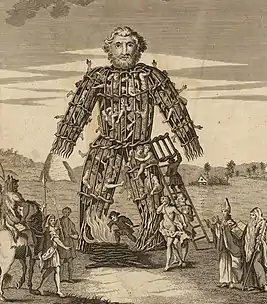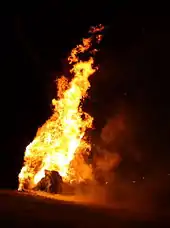Wicker man
A wicker man was a large wicker statue reportedly used by the ancient Druids (priests of Celtic paganism) for sacrifice by burning it in effigy.

The main evidence for this practice is one sentence in Julius Caesar's Commentary on the Gallic war,[1] which modern scholarship has linked to an earlier writer, Poseidonius.[2]
Modern archaeological research has not yielded much evidence of human sacrifice among the Celts, and the ancient Greco-Roman sources are now regarded somewhat skeptically, especially considering the likelihood that Greeks and Romans "were eager to transmit any bizarre and negative information" about the Celts at a time when the latter were feared and disdained.[3][4]
In modern times, the wicker man has been symbolically referenced as a part of some neopagan-themed ceremonies, without the human sacrifice, such as at Burning Man.[5] Effigies of this kind have also been used as elements in performance art, as display features at rock music festivals, and as thematic material in songs (such as the English heavy metal band Iron Maiden's song, "The Wicker Man"). A wicker man is featured in a pivotal scene of the cult British horror film The Wicker Man, and much of the prominence of the wicker man in modern popular culture and the wide general awareness of the wicker man as structure and concept is probably attributable to this film.
Ancient

While other Roman writers of the time, such as Cicero, Suetonius, Lucan, Tacitus and Pliny the Elder, described human sacrifice among the Celts, only Caesar and the geographer Strabo mention the wicker man as one of many ways the Druids of Gaul performed sacrifices.[6] Caesar reports that some of the Gauls built the effigies out of sticks and placed living men inside, then set them on fire to pay tribute to the gods. Caesar writes that though the Druids generally used those found guilty of crimes deserving death, as they pleased the gods more, they sometimes used slaves and thralls when no delinquents could be found.[7]
One medieval commentary, the 10th-century Commenta Bernensia, states that men were burned in a wooden mannequin in sacrifice to Taranis.[8]
Modern

Wicker men may be set ablaze during some contemporary pagan festivities. An effigy of wicker or other materials is burnt at the stake for the annual Danish celebration of Sankt Hans aften (Saint John's Eve). Modern wicker men range from life sized to huge, humanoid, temporary sculptures that are set ablaze during a celebration, usually toward the end of the event. They are constructed with a wooden frame that is woven with flexible sticks such as willow often used in wicker furniture and fencing. Some wicker men are extremely complex and require days of construction.[9]
2013_in_Wola_S%C4%99kowa%252C_Sanok.JPG.webp)
In Northern Portugal, the burning of gigantic human effigies is a tradition amongst some Portuguese villages which one can relate with Portugal's celtic past – the effigy has as its own name, Entrudo which comes from the latin word introits meaning introducing. This tradition is neither a recreation nor a neopagan revival, but a practice which has continued for centuries with some Catholic influence. The Entrudo Festival or Caretos Festival is practiced as a fertility ritual announcing the Spring – young adults dressed in colorful costumes and wearing horned masks (usually made of wood) hang around their village searching for young girls in order to symbolically 'fertilize' them; they may also 'fertilize' the village. The culmination of the festival is the burning of a gigantic human effigy with horns while young adults run around it.[10]
The Wickerman Festival was an annual rock and dance music event that takes place in Kirkcudbrightshire, Scotland; its main feature is the burning of a large wooden effigy on the last night.[11]
The Northern Italian version of the wicker man is called La vecchia ("the old lady") which is burned once a year as part of town festivals. However, it has a more Christian connotation since it is burned on Mid-Lent Thursday, as depicted in the film Amarcord by Federico Fellini.
See also
References
- "Others have figures of vast size, the limbs of which formed of osiers they fill with living men, which being set on fire, the men perish enveloped in the flames." Caesar, Julius (1915). Caesar's Commentaries. Translated by Macdevitt, W. A. Retrieved 6 July 2020.
- Ellis, Peter Berresford (1998). The Ancient World of the Celts. Barnes & Noble. pp. 64, 184, 187. ISBN 0-7607-1716-8.
- Wells, Peter S. (1999). The Barbarians Speak: How the Conquered Peoples Shaped Roman Europe. Princeton University Press. pp. 59–60. ISBN 0-691-08978-7.
- "Did The Celts Burn Human Sacrifices In A Huge 'Wicker Man'?". The Straight Dope. 1998.
- Wicker-Man: The Burning Question. Retrieved October 23, 2006.
- "Lugodoc's Guide to Druids". Lugodoc.demon.co.uk. 1985-06-01. Retrieved 2013-01-22.
- De Bello Gallico 6.16
- Mircea Eliade, A History of Religious Ideas, Vol. 2. University of Chicago Press (1982). § 171.
- Wickermanburn.org Archived September 24, 2008, at the Wayback Machine
- "Caretos de Podence". www.caretosdepodence.pt (in Portuguese). Retrieved 2017-04-11.
- Gallery Archived 2012-10-29 at the Wayback Machine, Thewickermanfestival.co.uk
External links
| Wikimedia Commons has media related to Wicker man (ritual). |
- Caesar, De Bello Gallico, English translation by W. A. McDevitte and W. S. Bohn (1869); Latin text edition, from the Perseus Project
- Project Gutenberg text for Frazer's The Golden Bough